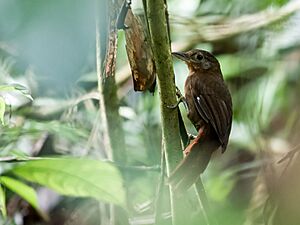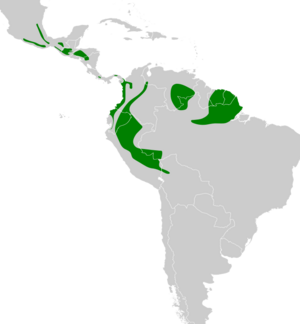Ruddy foliage-gleaner facts for kids
Quick facts for kids Ruddy foliage-gleaner |
|
|---|---|
 |
|
| Conservation status | |
| Scientific classification | |
| Genus: |
Clibanornis
|
| Species: |
rubiginosus
|
 |
|
| Synonyms | |
|
Automolus rubiginosus |
|
The ruddy foliage-gleaner (Clibanornis rubiginosus) is a type of bird that belongs to the ovenbird family. It lives in many different places, far apart from each other. You can find it in Mexico, several Central American countries, and most countries in South America.
Contents
Bird Families and Names
Scientists group living things into families. This helps us understand how they are related. The ruddy foliage-gleaner was once thought to be in the Automolus group. But new studies of its DNA showed it belongs in the Clibanornis group instead.
There are many slightly different types of ruddy foliage-gleaners. These are called subspecies. Scientists are still studying them. They think some of these subspecies might even be separate species!
Here are the 13 subspecies that many scientists agree on:
- C. r. guerrerensis (Salvin & Godman, 1891)
- C. r. rubiginosus (Sclater, PL, 1857)
- C. r. veraepacis (Salvin & Godman, 1891)
- C. r. fumosus (Salvin & Godman, 1891)
- C. r. saturatus (Chapman, 1915)
- C. r. sasaimae (Meyer de Schauensee, 1947)
- C. r. nigricauda (Hartert, EJO, 1898)
- C. r. venezuelanus (Zimmer, JT & Phelps, WH, 1947)
- C. r. cinnamomeigula (Hellmayr, 1905)
- C. r. caquetae (Meyer de Schauensee, 1947)
- C. r. brunnescens (Berlioz, 1927)
- C. r. watkinsi (Hellmayr, 1912)
- C. r. obscurus (Pelzeln, 1859)
What the Bird Looks Like
The ruddy foliage-gleaner is about 17 to 21.5 cm (6.7 to 8.5 in) long. This is about the length of a small ruler. Most of these birds weigh between 39 and 52 g (1.4 and 1.8 oz). This is about the weight of a few strawberries.
Both male and female birds look the same. The most common type, C. r. rubiginosus, has a dark reddish-brown face. It has a ring of bare blue skin around its eye. Its head and back are dark reddish-brown. Its wings and tail are also dark reddish-brown. The throat is a dark reddish-orange color. Its belly is a reddish-brown.
Other subspecies can look a bit different. Some are paler, some are darker. Some have more olive-brown colors, and some have almost black tails. Young birds have a lighter throat and chest than adult birds.
Where It Lives and Its Home
The ruddy foliage-gleaner lives in many places that are far apart. This is called a disjunct distribution.
Its subspecies are found in these areas:
- C. r. guerrerensis: Southwestern Mexico
- C. r. rubiginosus: Eastern Mexico
- C. r. veraepacis: Southern Mexico, Guatemala, Honduras, and northern Nicaragua
- C. r. fumosus: Southwestern Costa Rica to Panama
- C. r. saturatus: Panama to northwestern Colombia
- C. r. sasaimae: Western Andes mountains in Colombia
- C. r. nigricauda: Western Colombia, western Ecuador, and northern Peru
- C. r. venezuelanus: The tepui region where southern Venezuela and northwestern Brazil meet
- C. r. cinnamomeigula: Southwestern Venezuela and eastern Colombia
- C. r. caquetae: Eastern Andes foothills in Colombia and Ecuador
- C. r. brunnescens: Eastern Andean foothills in Ecuador and Peru
- C. r. watkinsi: Northern Peru to western Bolivia
- C. r. obscurus: the Guianas and northeastern Brazil
This bird lives in different kinds of forests. In Mexico and Central America, it likes humid evergreen forests, pine forests, and even coffee farms. It usually lives between 500 and 2,500 m (1,600 and 8,200 ft) high. In the Andes mountains, it lives in lowland and mountain forests up to about 1,500 m (4,900 ft). In other areas, it lives in tropical forests from near sea level up to about 1,300 m (4,300 ft).
It usually stays low in the forest, often near the bottom of ravines where plants grow very thickly.
Behavior and Habits
Movement
Most ruddy foliage-gleaners stay in the same place all year. They do not migrate. However, some birds in Mexico might move to different elevations depending on the season.
What It Eats
The ruddy foliage-gleaner eats many kinds of arthropods, like insects and spiders. It also eats small animals like frogs. It usually looks for food in pairs. It rarely joins other bird groups that are feeding.
It mostly searches for food in the lower parts of the forest. Sometimes it goes higher into the middle of the trees. It finds its food by picking it off dead leaves or decaying branches. Sometimes it even flips over leaves on the ground to find hidden snacks!
Reproduction and Life Cycle
Scientists are still learning about when and how the ruddy foliage-gleaner breeds. It seems to vary depending on where the birds live. These birds are monogamous, meaning a male and female bird stay together as a pair all year.
Their nests are like cups made of soft fibers. They build these nests inside a chamber at the end of a tunnel. These tunnels are dug into earthen banks. Usually, the female lays two eggs. She sits on the eggs at night to keep them warm. Not much else is known about how they raise their young.
How It Sings and Calls
The sounds the ruddy foliage-gleaner makes are different depending on the subspecies. In Mexico, its song sounds like a nasal "yeh'nk yeh'nk". Its calls there are a dry chatter or a repeated "chak".
In northern Central America, its call is a scratchy "Churee!-Churee!-Churee!". In Costa Rica and Panama, it makes many different sounds like "ka-kweek" or "a-whick". In Colombia, it makes a repeated "croak" sound. In Ecuador, it has a long, nasal "kweeeeahhhh". In other areas, its call is a sharp "chuck-kwihhh" where the second note goes up.
Conservation Status
The IUCN (International Union for Conservation of Nature) says the ruddy foliage-gleaner is a species of "Least Concern." This means it is not currently in danger of disappearing. It lives in a very large area. Scientists believe there are at least 500,000 adult birds, but this number might be going down.
No major threats have been found for this bird. It is found in patches, meaning it's not everywhere. Some places it's rare, and in others, it's quite common. It also lives in protected areas in several countries, which helps keep it safe.


